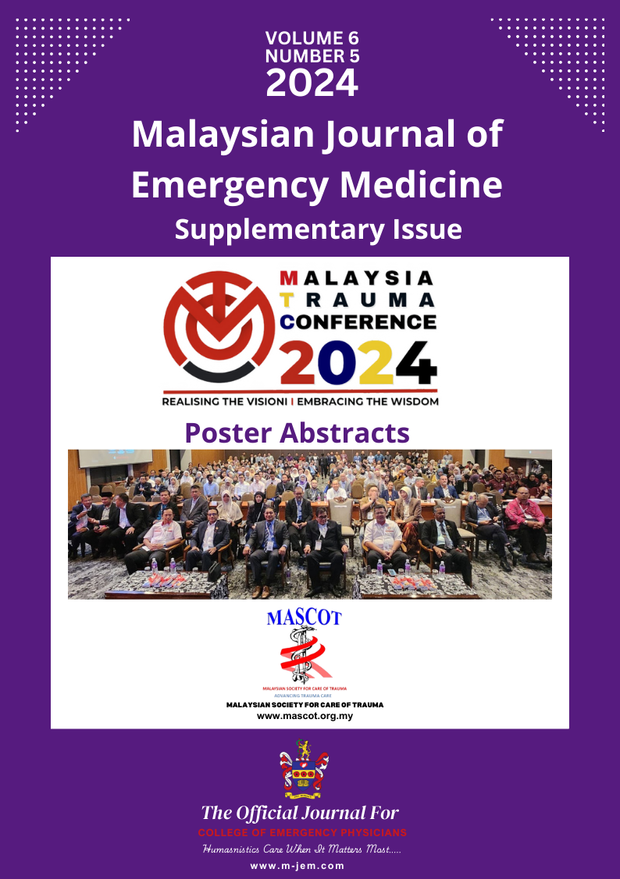A31 Traumatic Cardiac Arrest Complicated with Bilateral Hemopneumothorax
Main Article Content
Abstract
INTRODUCTION
Traumatic cardiac arrest (TCA) is a rare but highly fatal event, often resulting from blunt or penetrating trauma. A complication that can severely compromise respiratory function and hemodynamics, adds to the complexity of TCA. This case report highlights the critical importance of rapid diagnosis and intervention in the management of TCA with bilateral hemopneumothorax.
CASE DESCRIPTION
A 54-year-old male was brought to the emergency department (ED) by ambulance after a high impact trauma. On arrival, the patient was unresponsive, pulseless, and apneic. Cardiopulmonary resuscitation (CPR) was initiated.
Initial Assessment and Management:
Airway: The patient had a secured airway with a cervical collar in place. Endotracheal intubation was performed by ED team.
Breathing: Bilateral absent breath sounds were noted. Immediate bilateral finger thoracosmy was performed.
Circulation: The patient was in pulseless electrical activity (PEA). External chest compressions were continued, and intravenous access was established.
Disability: Glasgow Coma Scale (GCS) was 3 (E1V1M1).
Exposure: No other significant external injuries were initially noted.
Focused Assessment with Sonography for Trauma (FAST):
- Positive for bilateral hemopneumothorax and no free fluid seen.
Interventions:
Chest Tube Insertion: Bilateral large-bore chest tubes were inserted in the fifth intercostal space, anterior axillary line, with immediate return of air and blood.
Fluid Resuscitation: Aggressive intravenous fluid resuscitation with crystalloids and blood products was initiated.
DISCUSSION
Traumatic cardiac arrest with bilateral hemopneumothorax presents a critical challenge requiring swift diagnosis and intervention. This case underscores the importance of immediate recognition and intervention, including finger thoracostomy, chest tube placement. Adherence to advanced trauma life support (ATLS) principles are crucial for improving outcomes in such dire circumstances.
Traumatic cardiac arrest, particularly in the setting of bilateral hemopneumothorax, poses unique challenges. Bilateral hemopneumothorax results from significant trauma to the chest, leading to the accumulation of both air and blood in both pleural spaces. This can severely compromise lung expansion, decrease venous return to the heart, and lead to cardiovascular collapse. Without rapid intervention to decompress the pleural cavities, the patient is likely to succumb to hypoxia and tension physiology.
In this case, the bilateral nature of the hemopneumothorax complicated the resuscitation. The patient required immediate decompression to relieve tension physiology and permit effective ventilation. The additional complication of cardiac arrest necessitated aggressive interventions, including a resuscitative thoracotomy, to address underlying injuries.
CONCLUSION
Timely diagnosis, appropriate resuscitative measures, and surgical intervention were pivotal in achieving a favorable outcome for the patient. Continued efforts in trauma education and protocol development are essential to enhance the care of patients experiencing similar traumatic events.
Metrics
Article Details

This work is licensed under a Creative Commons Attribution-NonCommercial 4.0 International License.

